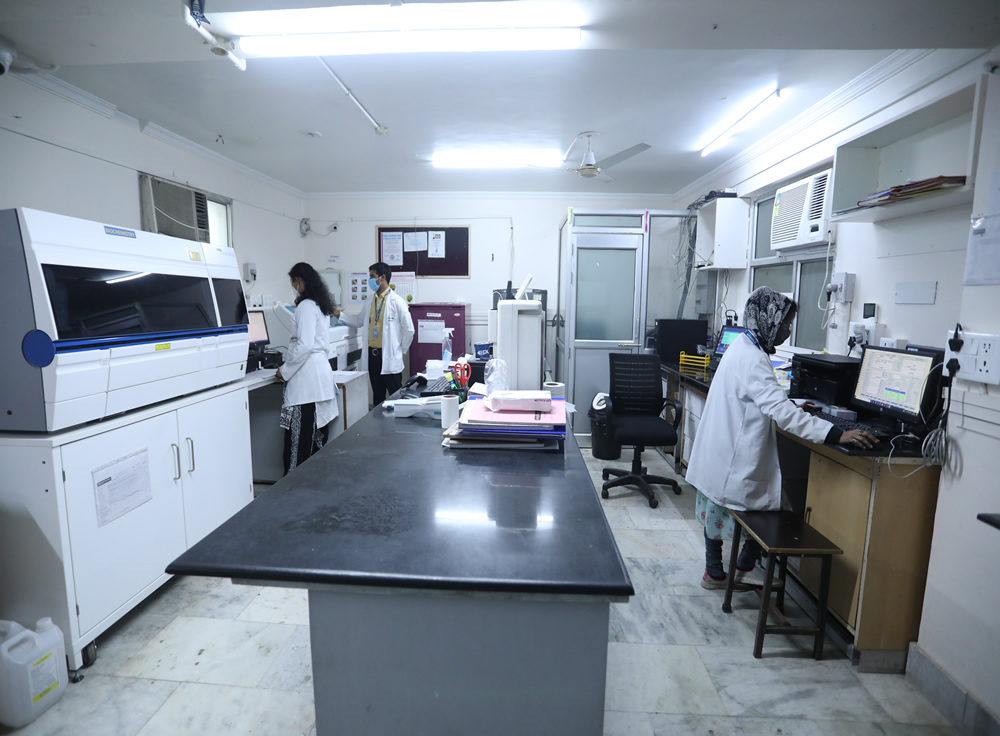Department of Radiology
The radiology department in a medical facility is a crucial component of patient care, specializing in diagnostic imaging and therapeutic procedures. The Department of Radiology is equipped with an advanced Imaging facility and offers comprehensive services that cover a large spectrum of disease profiles to support patient clinical diagnosis. The 32-slice CT scan from Seimens offers a one-stop solution for high-definition diagnostic imaging services for all patients.

Facilities available
1. Diagnostic Imaging Modalities
Radiology departments utilize various imaging techniques to diagnose diseases and conditions. These may include:
2. Diagnostic Interpretation
Radiologists analyze imaging studies to diagnose diseases and injuries, often collaborating with other medical specialists to provide comprehensive care. They provide detailed reports of their findings to referring physicians.
3. Interventional Procedures
Radiology departments offer minimally invasive procedures for both diagnostic and therapeutic purposes. These may include:
- Biopsies: Extracting tissue samples for analysis.
- Angiography: Imaging of blood vessels, often followed by procedures such as angioplasty or stent placement.
- Tumor Ablation: Destroying tumors using heat, cold, or radiation.
- Pain Management: Administering injections or nerve blocks to alleviate pain.
4. Quality and Safety
Radiology departments adhere to strict quality and safety standards to ensure accurate diagnoses and minimize risks to patients. This includes radiation safety protocols, contrast agent administration guidelines, and infection control measures.
5. Patient Care and Communication
Radiology departments prioritize patient comfort and safety during imaging procedures. Clear communication with patients regarding the procedure, potential risks, and follow-up care is essential for a positive patient experience.
Department of Radiology offers
- Routine & high-resolution ultrasound of Abdomen, Kidneys, Gynaecology & Obstetrics
- 3D & 4D Ultrasound
- Colour and power Doppler of the whole body including peripheral vascular colour Doppler.
- Musculoskeletal and Gastro Intestinal Ultrasound.
- Whole body CT scan (32-slice)
- CT-guided intervention
- Contrast and Barium studies
- Mammography with Computerised Radiography system
- High-end Ultra-sonography for Abdomen
- Obstetric and Gynaecological Ultra-sonography
- Paediatric Ultra-sonography
- Vascular Doppler studies
- Foetal Echo-cardiography
- Musculoskeletal & small-parts Ultra-sonography
- Interventional Ultra-sonography
- Mobile and bedside X-ray
Overall, the radiology department plays a vital role in modern healthcare, contributing to the diagnosis and treatment of a wide range of medical conditions through state-of-the-art imaging techniques and interventional procedures.
The pathology department is a crucial component of healthcare institutions, specializing in the study and diagnosis of diseases through the examination of tissues, organs, bodily fluids, and cells. The Department of Laboratory Medicine provides a precise/accurate/superior quality lab diagnostic service to its patients through an automated process. The services are available round the clock driven by the philosophy to provide high-quality accuracy lab results at affordable pricing and high ethical standards. The pathology Lab of Jeevan Jyoti Hospital is accredited by the prestigious National Accreditation Board for Testing and Calibration Laboratories (NABL).
1. Anatomical Pathology
- Histopathology: Involves the examination of tissues obtained from biopsies, and surgeries to diagnose diseases such as cancer, infections, and inflammatory conditions.
- Cytopathology: Focuses on the study of individual cells obtained from various body sites, often through methods like fine needle aspiration or Pap smears, to detect cancer or other abnormalities.
2. Clinical Pathology
- Clinical Chemistry: Analyzes blood, urine, and other bodily fluids to assess organ function, diagnose diseases, and monitor treatment effectiveness.
- Hematology: Studies blood and blood disorders, including the analysis of blood cell counts, coagulation tests, and blood smears to diagnose conditions such as anemia, leukemia, and clotting disorders.
- Microbiology: Identifies and characterizes infectious agents such as bacteria, viruses, fungi, and parasites to guide treatment decisions and infection control measures.
- Immunology and Serology: Evaluates the body's immune response and detects antibodies or antigens associated with autoimmune diseases, infectious diseases, and allergies.
3. Diagnostic Techniques
- Microscopy: Utilizes microscopes to examine tissue samples, cells, and microorganisms for structural abnormalities or characteristic features.
- Molecular Diagnostics: Uses techniques such as PCR (polymerase chain reaction) and DNA sequencing to detect genetic mutations, infectious agents, and biomarkers associated with diseases.
- Flow Cytometry: Analyzes cells based on their physical and chemical properties, often used in diagnosing hematological malignancies and immunodeficiencies.
4. Interdisciplinary Collaboration
Pathologists work closely with clinicians, surgeons, radiologists, and other healthcare professionals to provide accurate diagnosis, interpret test results, and guide patient management and treatment decisions.
5. Quality Assurance and Accreditation
Pathology laboratories adhere to rigorous quality control measures and participate in external proficiency testing programs to ensure the accuracy and reliability of diagnostic tests and results.
The lab facility is equipped with various fully-automated and proven technologies which optimise analysis and offer a wide range of services:
The Department of Laboratory Medicine has adopted a vacuumed closed sample collection technique, bar-coding of specimen containers, and Bi-directional interfacing. These help in minimizing pre-analytical errors.
Overall, the pathology department plays a fundamental role in healthcare by providing essential diagnostic information to support clinical decision-making, disease management, and patient care across a wide range of medical specialties.